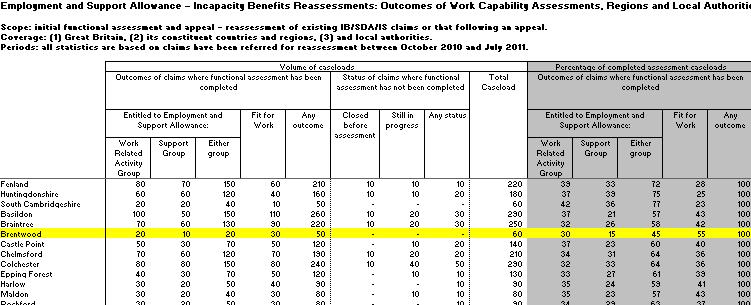Are most incapacity benefit claimants found fit for work in some parts of the country?
"More than half of incapacity benefit claimants in some parts of the country are perfectly fit to work, investigators have found."
Daily Mail, 21 April 2012
"Most sick benefit claimants are fit to work"
The Daily Echo, 22 April 2012
In the wake of the Department's first publication of national information from the incapacity benefits reassessment on 15 March, on Friday the Department for Work and Pensions (DWP) released a geographical breakdown of the data that has been gathered so far.
The reassessment of the status of the 1.5 million claimants currently receiving incapacity benefit to ensure they are eligible for the new Employment and Support Allowance (ESA) began on a national scale on 4 April, 2011, and the DWP currently maintains a projected completion date of spring 2014 for the reassessment process.
Over the weekend, the Daily Mail has dubbed Brentwood, Essex, the "skiving capital of Britain" with 55 per cent of claimants found to be eligible to work. The issue has received coverage, with different publications interpreting the data in a variety of ways.
Analysis

This study released by the DWP, assessing only a proportion of the total due to the ongoing assessment that will continue until 2014, indicates that the percentage of claimants deemed 'Fit for Work' within local authorities ranged from 55 per cent to 17 per cent. In Brentwood's case, they were at the top end with 55 per cent of around 60 cases.
It is worth bearing in mind that the figures give no indication of the actual number of reassessments taking place in each locality, and they only provide data up to July 2011.
For instance, the regional estimates indicate that the South East has the lowest percentage of existing claimants found 'Fit for Work' at 31 per cent, amounting to around 3,660 cases. In contrast, the North East has a higher percentage of 40, and yet this higher percentage amounts to a lower number of actual cases, with 2,660 claimants found Fit for Work.
This data has been updated since the previous publication, which did not incorporate the results of appeals made by claimants, but remains a provisional set of figures as nearly 12,000 cases are yet to be included.
As Full Fact has found in the past, when looking at Fit for Work figures care must be taken as only those who are entered into the Fit for Work category can be considered to be such, not those claimants placed into the 'Work-Related Activity Group' (WRAG) which only indicates that they may potentially work in the future.
However, as the table taken from the DWP's most recent Work Capability Assessment report shows, the facts seem to be in order with 55 per cent of claimants in Brentwood reassessed as Fit for Work - although above the national average of 37 per cent (we cannot as yet attest to just how many cases this indicates).
The same cannot be said for the article appearing yesterday in the Daily Echo with the rather sensational headline: "Most sick benefit claimants are fit to work".
However their definition of 'fit to work' leaves much to be desired. The opening claim of the paper that "more than two-thirds of Hampshire's incapacity benefit claimants are being judged capable of work" can only be true if conflating those classified as Fit for Work with those claimants in the Work Related Activity Group. But to be placed in the WRAG one has to be:
- "Suffering from a life threatening disease in relation to which there is medical evidence that the disease is uncontrollable."
- "An in-patient in a hospital or similar institution."
- "[Receiving] regular weekly treatment by way of by way of haemodyalisis or chronic renal failure."
- "Receiving treatment by way of intravenous, intraperitoneal or intrathecal chemotherapy."
Such individuals are not 'Fit for Work' as described by the Daily Echo. Instead the DWP defines the Work Related Activity Group as those who, with the right support, may be able to return to work at some point in the future.
Conclusion
It is true that, according to government statistics, 55 per cent of incapacity benefit claimants have been reassessed as Fit for Work in Brentwood, justifying the Mail's headline.
But it is important to remember that this figure of 55 per cent is the highest in the report, with some areas as low as 17 per cent (Bexley and Wealden), 18 per cent (Ribble Valley, Greenwich and Surrey Heath) and 19 per cent (Perth & Kinross).
It is also dangerous to dub Brentwood the "skiving capital of Britain" based on a sample of only around 60 cases - one the smallest caseload figures across all 390 areas in the study. There is also no data to indicate whether these individuals are fraudulently 'skiving' work or whether this is just a result of more stringent assessment criteria.
The Daily Echo's headline is, however, misleading. While the article demonstrates later on that it appreciates the different categories of assessment, it is not correct by the statistics to say that "more than two-thirds" of Hampshire's (or indeed anywhere else's) assessments found a Fit for Work claimant.